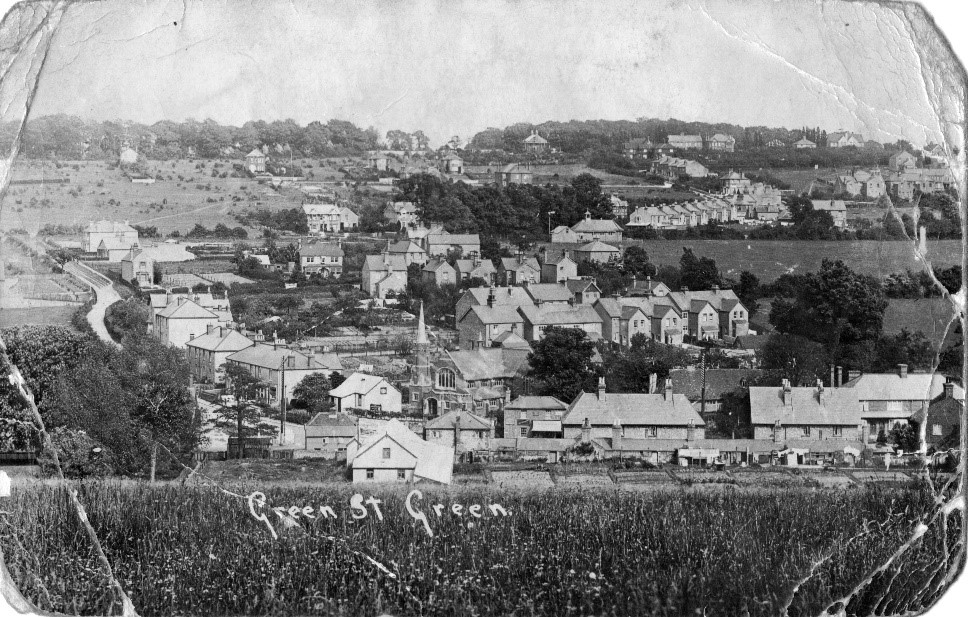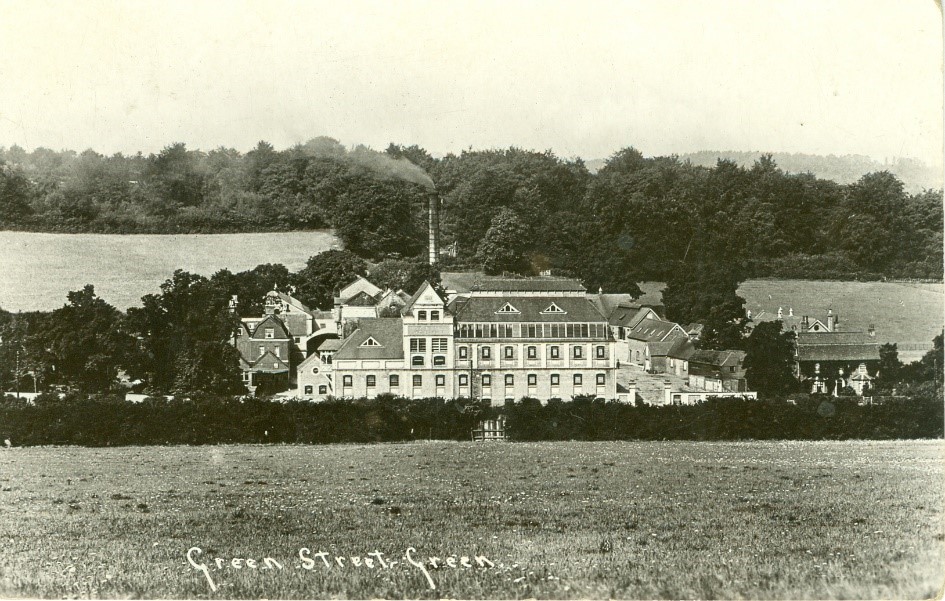


AN UNSETTLING AUCTION
The page The Oak Brewery describes how the brewery in Green Street Green came into being, transforming what had been a hamlet into a village in its own right. However, being very heavily dependant on a single employer it was vulnerable to the fortunes of that busines. If it were to fail, then the consequences could be serious. This is exactly what happened, some seventy years after the brewery first opened.
This article and the one that follows pick up the story.
Click images and maps to enlarge. Maps copyright Ordnance Survey
An Unsettling Auction for Green Street Green 100 years ago
By Patrick HellicarA century ago, in July 1920, the people of Green Street Green were pondering – probably with some trepidation – the prospect of a big change in ownership of many acres of land and numerous properties in and around the village.
Over the previous 10 years they had already seen dramatic upheavals. Fox’s Oak Brewery, whose monolithic brick edifice with its tall chimney and numerous outbuildings had towered over the High Street for many decades, had gone out of business on 15 July 1909, brought to its knees despite its award-winning ales and stouts by poor management and huge debts. With the brewery’s demise, an established way of life had been swept away.
 |
| The Village as it looked about 1910 |
That surely came as an incomprehensible shock to the villagers whose fortunes had been tied to the apparently-prosperous Fox’s for so long. Over 100 jobs disappeared and the social and leisure facilities the philanthropic-minded Fox family had bestowed on Green Street Green as their business flourished and grew, were suddenly under threat.
Lost along with the skilled brewing jobs and back-office clerical work were all those humbler but essential day-to-day jobs that had kept Fox’s self-sufficient and provided folk from the village and surrounding areas with steady, relatively good earnings. An army of building maintenance men, carpenters, blacksmiths, wheelwrights, barrel-makers, draymen, stablehands, fetchers and carriers of all kinds was no longer needed. Fox’s was the only employer of any size, so many locals had no choice but to leave the hamlet they called home and try to find work further afield.
Fox’s had, in fact, been struggling for years and the brewery, its bricks and mortar assets, pubs and equipment, horses and all the other paraphernalia of the business had gone under the auctioneer’s hammer in mid-1907. Enough money was raised to pay off the firm’s crippling debt but the massive building itself, on offer together with 37 licensed houses, failed to find a buyer. Bids reached £89,000 but the Foxes had hoped for more and withdrew the Lot.
In April 1909 the family put the brewery up for sale again – but again the bids were deemed too low. A couple of months later, however, Truman, Hanfield & Buxton & Co, owner of the Black Eagle Brewery in Spitalfields, stepped in to take 28 of the licensed houses off Fox’s hands. The following year, Golding & Co’s Bat & Ball Brewery at Sevenoaks snapped up Fox’s private trade, goodwill and retail licence. They renamed their Bat & Ball operation “Oak Brewery” and, with trade expanding rapidly, took space in the increasingly-dilapidated buildings at Green Street Green for storage.

During the First World War, the deserted brewery found a new role. It was pressed into service as army barracks, providing a billet at different times for troops of the Honourable Artillery Company, the Welsh Guards and the London Regiment – that invasion unsettling the village and its community once more.
Come 1920, however, some things had barely changed at Green Street Green. The soldiers had departed but the defunct brewery, dark and brooding, still dominated the village. At the other end of the High Street, the little red-brick school founded by the Foxes in 1851 and funded by them ever since, continued to cater for the children of the neighbourhood. A number of the old brewery cottages scattered around were still rented by families with deep roots in the area. (Back in 1888, it had been noted that Fox’s had provided 30 cottages for employees.) Several large properties once occupied by senior employees of the brewery had been let to other tenants but remained in Fox ownership, along with dozens of acres of land.
Now, in the middle of a cold, dull, very wet and miserable summer, it looked as if things were going to be upset again. By order of T Hamilton Fox and Walter St John Fox – the brewery founder’s grandsons on whose watch the business was strangled as they added to its already-heavy debt burden – 16 lots of property on the village’s doorstep were up for grabs in yet another auction. The sale of “The Beechwood Estate, Farnborough, Kent” was to be conducted by agents Debenham, Tewson & Chinnocks. The big day was Tuesday 13 July and bidding would begin at 2.30pm in Room 30 of Winchester House at Old Broad Street in the City of London.
Alongside, at the same time, Debenham, Tewson & Chinnocks once more sought bids for the Oak Brewery itself. Sitting on about four acres fronting the main road for a distance of 500 feet or so, the property was particularly suitable for carrying on a brewery business, they observed. But “the premises could readily be adapted and expanded to meet the requirements of almost any manufacturing trade or business”. Unfortunately, the brewery was again unsold.
Biggest prize of all was Lot 1, the Fox family’s former home, Beechwood, set well back off Shire Lane towards Old Hill. It was, declared the auctioneers, a “very attractive and desirable” 13-bedroom “excellent family residence” well away from motor traffic, standing in an “elevated and secluded position” 300 feet above sea level amid finely timbered grounds stretching to almost 39 acres.

Included was a picturesque red-brick lodge house on Shire Lane. Black and white photographs tempted potential buyers with views of Beechwood’s lodge (below, right), the 240-yard carriage drive, tennis lawn, herbaceous borders and a woodland walk.
.jpg) |
 |
The other main houses on offer were, the “moderate-sized” The Elms, with five bedrooms, a spacious garage, tennis lawn, well-stocked kitchen garden and “exceptionally pretty and well-kept grounds” of more than an acre; The Poplars, “a charming old-fashioned residence” with seven bedrooms but less than an acre of ground, screened from the road by a belt of limes, chestnuts, pines and other trees; and the picturesque, old-fashioned Wellhurst with three main bedrooms plus one smaller and about three-quarters of an acre of land.
Also on the auction block was Oak Farm, “a capital freehold agricultural holding” of just over nine acres with a frontage to the main road measuring 1,060 feet – “thus affording opportunities, if desired, for development by building operations”. It included two red-brick and tiled cottages, one with two bedrooms, the other with three, plus substantial farm buildings such as a granary, cart shed, cow shed, piggeries, stabling and a collection of other sheds, barns and lean-tos as well as three enclosures of arable and grass land.

The village Recreation Club along with a couple of brewery cottages and scraps of land made up Lot 12, while a total of 15 brewery cottages strung along the High Street and three nestling at Old Hill were parcelled up in other lots.
Just off Old Hill, 18 acres of valuable freehold land in a high, desirable position with “exceptionally fine views” to the south-east over “many miles of undulating well-wooded country” was a key part of the sale. Adjoining it was a separate acre or so of building land then being used as 20 allotments but deemed “suitable for the erection of one or more moderate-sized residences or cottages”.
How exactly the day went, I don’t know. Across the country in that post-WW1 period auction sales were difficult. The combination of lost heirs, labour shortages, death duties, crippling taxes introduced to pay for the war and declining farm rentals had proved too much for legions of large landowners to bear and many simply gave up in despair. Estates that had been handed down through generations were put on the market wholesale or were broken up with outlying bits sold off piecemeal. So much land and property was looking for buyers that prices were depressed. Bids often didn’t reach reserve levels. Sometimes, there were no takers at all.
Nevertheless, by the end of that Tuesday afternoon in the City 100 years ago, at least some Fox property and land had passed into different hands. A world away, back at Green Street Green, folk braced themselves for the inevitable changes the village would see as a result.
After the Auction
